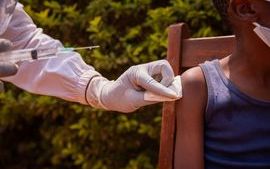- Published:
- 16 October 2025
- Author:
- Dr Clare Gilham
- Read time:
- 12 Mins
Screening, improved testing and vaccination are having a transformative effect on HPV and cervical cancer rates. In this article, Dr Clare Gilham explores these strategies designed to reduce cervical cancer incidence in England.
Almost all cervical cancers are caused by human papillomavirus (HPV) infection.1 There are 13 recognised carcinogenic HPV types, but 7 types (HPV16, HPV18, HPV31, HPV33, HPV45, HPV52 and HPV58) are estimated to cause 95% of cervical cancers worldwide.2 HPV16 is associated with the highest risk, causing around 62% of cervical cancers. HPV is extremely common in Britain, particularly among young women, but most new infections are transient and are controlled by the immune system within 1–2 years.
At recruitment to our large screening trial in Manchester in 2000–2003,3 40% of women aged 20–24 and 28% of those aged 25–29 tested positive for HPV. This high prevalence on a single test implied that most British women would be infected with HPV at some time in their lives. Persistent infection is both the cause of precancer and a reliable marker of its presence.4–6 The risk is greatly reduced by screening and treatment of less advanced lesions, but women who are not vaccinated or screened regularly are at high risk of developing cervical cancer.
Following the development of effective prophylactic HPV vaccines, NHS England has pledged to reduce age-standardised cervical cancer incidence to less than 4 per 100,000 per year by 2040.7 This is the level defined by the WHO as ‘elimination’, where cervical cancer will cease to be a major public health problem8 and will require high coverage of both vaccination and screening. The incidence of cervical cancer in England is currently 8.5 per 100,000, higher than in many other European countries. The mortality rate, however, is 2.0 per 100,000 – one of the lowest in the world,9 due to the success of the NHS Cervical Screening Programme in early detection, as well as prevention of cancer.
The NHS offered opportunistic cervical screening from the 1960s, but population coverage was low, particularly in older women, as most women screened were attending for obstetric or contraceptive reasons.10 In 1988, the call–recall programme was introduced, which included financial incentives for GPs and invited all women aged between 20–64 years to attend screening every 3–5 years. The number of smears had increased from around 3 million per year in 1983 to around 4.5 million by 1988,10 but coverage then rose from 42% in 1988 to 85% in 1995.11 As a consequence, the NHS Cervical Screening Programme is highly effective; cervical cancer incidence and mortality have declined considerably since 1988.12
Several major changes have been made to the screening programme since 1988, but the most radical change was switching from primary cytology to primary HPV testing in 2019. Prior to 2019, the cytology test was followed by HPV triage to decide whether low-grade abnormalities should be referred to colposcopy or returned to routine recall. Since 2019, HPV testing has been done first, followed by cytology triage of HPV-positive women.
In practice, the biggest difference between the 2 protocols is the management of women who test HPV-positive and cytology-negative, who constitute the majority of women with HPV infections. The current protocol recalls these women for annual repeat HPV testing, whereas those who remain positive after 2 years are referred to colposcopy. Any intermediate abnormal cytology also triggers referral.13 Currently, all women aged 25–64 are invited for HPV screening every 5 years.
Given the high prevalence of HPV infection, particularly among young women, there is ongoing research into developing a better triage test to identify the HPV-positive women at highest risk. Cytology is the default triage test in the UK and many other countries because of its previous long use. Some countries, such as Sweden, Australia and Denmark, are also starting to stratify women according to HPV genotype. Some NHS laboratories use partial genotyping tests, but this information is not used for management nor reported to the patient or clinician in the UK.
The most recent change to the NHS programme was the announcement in June 2025 that self-sampling will be an option for non-attenders. This was recommended following research undertaken by English NHS laboratories, which showed similar sensitivity to clinician-taken cervical samples for detecting precancerous lesions.14 A large study of self-testing among non-attenders in London showed that uptake was significantly higher when a healthcare professional offered the kits in person.15
Self-testing addresses barriers to attending for a cervical screen, including pain, anxiety, embarrassment and inconvenience.16 The main disadvantage of self-sampling is that cytology triage cannot be done on the sample, so women testing HPV-positive have to attend their GP to have a cervical sample taken, and follow-up may be inadequate.17
This is where management based on genotype could be advantageous, as there is an argument for immediate referral of those who test HPV-positive for HPV16/18 on a self-screen and have not been screened for a long time.18 There is also growing evidence that urine testing is comparable to vaginal self-sampling in terms of sensitivity,19 and may be preferable to some groups, including transgender individuals.20
The school-based HPV vaccination programme for 12–13-year-old girls began in 2008 and included a catch-up for girls aged 14–17 in 2008–2010, so all girls born since September 1990 have been offered vaccination in the UK. Recent evidence for the efficacy of receiving just a single dose has led to this being national policy from September 2023.21 Vaccination has also been offered to boys since 2019 but with slightly lower uptake than girls. The coverage in girls remained over 85% until the COVID-19 pandemic, but has since declined. In 2023, coverage was 74% among Year 9 girls and 69% among Year 9 boys.22 To address the decreasing coverage the NHS has just announced a catch-up programme where unvaccinated people under the age of 25 will be invited by their GP to book an appointment for vaccination.23
The enormous impact of vaccination is now being seen, as the first vaccinated women are attending for screening. These women, born between 1990 and 1994, were vaccinated a little older, around age 14–17, with a coverage of about 60%.24 The prevalence of HPV16/18 infection among English women aged 24–25 decreased from 13.5% in 2014 to 3.1% in 2018, along with a halving of pre-cancerous lesions;25,26 no cervical cancers have been observed to date in Scottish vaccinated women.27 Vaccination increased herd immunity, reducing the risk even in unvaccinated women;28 from 2015 to 2022, cervical cancer incidence in England fell by 90% below age 25 and by 80% at ages 25–29.29
The first vaccines included only types HPV16 and HPV18. Since 2019, a vaccine including the 7 high-risk genotypes that cause approximately 95% of cancers has been used in the NHS school-based programme. Almost all cancers seen in women aged under 30 are caused by HPV16 or HPV18,30 but more cancers caused by other genotypes may be seen among vaccinated women as they age. They should recognise that they are still at risk and attend for screening when invited, though their frequency of screening can probably be reduced to 2 or 3 screens per lifetime.31
The school-based HPV vaccination programme has been a great success despite recent downward trends in uptake. We estimated that England is likely to reach the NHS and WHO target incidence of 4 per 100,000 by 2040, largely due to aging of the vaccinated cohorts.29
The addition of self-sampling to reduce inequalities and increase coverage will contribute to increased prevention and early detection. Maintaining regular screening is particularly important in older unvaccinated women, who will remain at higher risk owing to HPV infections acquired when they were young.
References available on our website.




